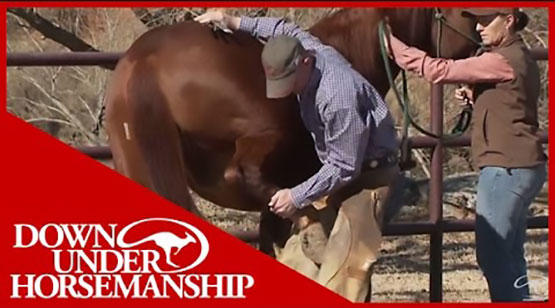Solving a Severe Kicking Habit
The Subjects:
Cutting competitor, Cindy Love-Eicher, contacted me about her 7-year-old gelding, Blue, who had a dangerous kicking habit.
The Situation:
Blue started getting fussy with his feet, not standing still while Cindy handled them, and getting anxious around the farrier, when he was 3. Over time, his problem escalated to the point that no one was able to touch his legs without him kicking out violently. In fact, the farrier had been seriously struck by him twice.
The Solution:
When I first met Blue and talked with Cindy, it was obvious the gelding had little respect for his handlers and was fearful of his legs being touched. Before working on Blue’s kicking problem, I needed to earn his respect, get control of his feet and prove to him that I wasn’t going to harm him. Horse problems are nothing but symptoms of a cause. Fix the cause, and the problem will take care of itself. So the first step was to forget about his feet and instead get the fear out of him and earn his respect. I knew if I went for his feet straightaway, I’d end up in a wreck just like Cindy.
Establish a Starting Point
The first step was to desensitize Blue to me and my tools using the Approach and Retreat Method (approaching the horse with an object and not taking the object away until he stands still and shows a sign of relaxing). When a horse relaxes, he’ll do one of five things: 1) lower his head and neck, 2) blink his eyes, 3) cock a hind leg, 4) take a deep breath or 5) lick his lips.
I began by desensitizing him to the lead rope and then the stick and string, and at first, he was very scared of both objects and tried to escape them by running backwards. But, using Approach and Retreat, he realized that reacting wasn’t the answer to making the objects go away; standing still and relaxing was.
Once I had his body desensitized to both of the tools, then I could use them to work on his legs, especially the stick. Both tools acted as an extension of my arm and allowed me to touch Blue’s legs without putting myself in a vulnerable position where I could get hurt. The lead rope and stick are the bravest things in the world. Blue could kick out at them as much as he wanted, but they weren’t going anywhere until he stood still and showed a sign of relaxing.
Foot Control
After desensitizing Blue, I moved on to getting control of his feet by using the exercises Yield the Hindquarters and Lunging for Respect. In Yield the Hindquarters, I ask the horse to pivot on his front legs as he moves his hind end away from me. Unlike traditional lunging, where the horse is made to circle continuously around his handler, in Lunging for Respect the focus is on asking the horse to change directions by doing a rollback. Getting control of Blue’s feet would accomplish two things: 1) moving a horse’s feet forwards, backwards, left and right is how you earn respect, and 2) moving a horse’s feet and constantly asking him to change directions gets him to relax and use the thinking side of his brain. Before I started working on Blue’s feet, I needed to be able to control him and have him using the thinking side of his brain, otherwise, I would have little control and the situation could turn dangerous.

I practiced Approach and Retreat with Blue’s leg to build his confidence about having me handle his feet.
One Step at a Time
Now that I had earned Blue’s respect, he was using the thinking side of his brain and he was no longer fearful of me or my tools, I felt confident addressing his feethandling problem using the steps described. Since Blue was the most defensive of his back legs, that’s where I focused my efforts.
I began by desensitizing Blue’s legs to the lead rope by seesawing the rope back and forth and up and down his hind leg. I started up high on his leg because the lower down the leg you go, the more sensitive the horse is. Anytime Blue moved or kicked out at the rope, I just kept his head tipped toward me and seesawed the rope like nothing happened. As soon as he stopped kicking, stood still and relaxed, I stopped seesawing the rope and rubbed his face.
When he was comfortable with me seesawing the rope on his leg, then I began rubbing his leg with my hands. Whenever you work with a horse’s back legs, always keep the horse’s head tipped toward you so that if he did move, his hindquarters would swing away from you. A horse’s hindquarters always move the opposite way his head and neck are tipped.
Initially, I used just one hand to rub Blue’s leg, keeping my free hand on his hindquarters so that if he did try to kick out or run off, I could easily feel him start to move and could stay with him. When he was OK with me using one hand to rub his leg, I used both hands to desensitize him to my touch. This step is very important because if a horse isn’t perfectly comfortable with you rubbing down his legs, he’ll inevitably give you resistance when you try to pick his foot up.
When I could rub my hands up and down Blue’s hind leg without him kicking out, then I positioned the lead rope so that it ran under his fetlock and used it to pick his back foot up. As soon as Blue responded by taking his weight off his leg, I immediately released the pressure. Each time I applied pressure to his leg, I was looking for him to raise his leg a little farther. Initially, Blue did struggle with the pressure and kicked out, but I only released the pressure when he stood still and took his weight off his leg. If he was kicking out or moving around, I didn’t release the pressure. Before long, he realized that the only way to make the pressure go away was by standing still and submitting.
Using the lead rope to pick up his foot allowed me to stay a safe distance away from his hind leg in case he did kick out and proved to him that I wasn’t trying to hurt him. He thought that every time he felt pressure around his leg it was going to be a battle. I wanted to be casual about the whole thing and show him that as long as he responded by taking the weight off his leg, he’d get a release of pressure.
When I could rub my hands up and down Blue’s leg and pick his foot up with the lead rope without him kicking out, I taught him a cue to pick his foot up. When working with a horse’s back legs, I cue him to pick up his feet by lightly squeezing the cap of the hock. I start by gently squeezing the cap of the hock, then increase the pressure by squeezing harder and harder. As soon as Blue responded by taking his weight off his leg, I immediately released the pressure and rubbed his leg.
When he understood the cue to picking up his foot, then I held it in my hand for a split second. At this point, I wasn’t interested in trying to hold the foot up for any length of time. It’s almost as though I was picking it up and dropping it so fast that Blue thought, “Was he just holding my foot?” I wanted to drop his foot before he had time to start struggling. Then I gradually increased the amount of time I held the foot up off the ground. Instead of picking up the foot and waiting until Blue tried to pull it away or kick out, I picked up his foot and dropped it before he had a chance to react. One second soon turned into two, then three, and so on.
As I held his foot up, I started to rub his leg with my free hand to get him used to having his leg handled while it was off the ground. It’s important to rub the horse’s leg vigorously to show him that there’s nothing to be worried about. Remember, the more you sneak around a horse, the more reason you give him to be anxious and worried.
Now of course, throughout this process, Blue did struggle some. After all, he had a longstanding habit of kicking. Anytime he got defensive about me touching his legs and kicked out, I immediately dropped his foot and put his feet to work. I yielded his hindquarters really fast, backed him up aggressively and made him really hustle for a few minutes. Then I brought him to a stop and went straight back to picking his foot up. I wanted him to realize that he had two options: Option A—stand still and relax while I handle your foot, or Option B—work hard and sweat. Since horses are basically lazy creatures— they’d rather stand still and relax than have to work hard—they’ll pick the option with the least amount of work involved. So it didn’t take Blue long to realize that as long as he stood still and relaxed while I handled his legs, life was good. But when he kicked out and threw a fit, he had to hustle his feet and work hard. I made the right thing easy and the wrong thing difficult.
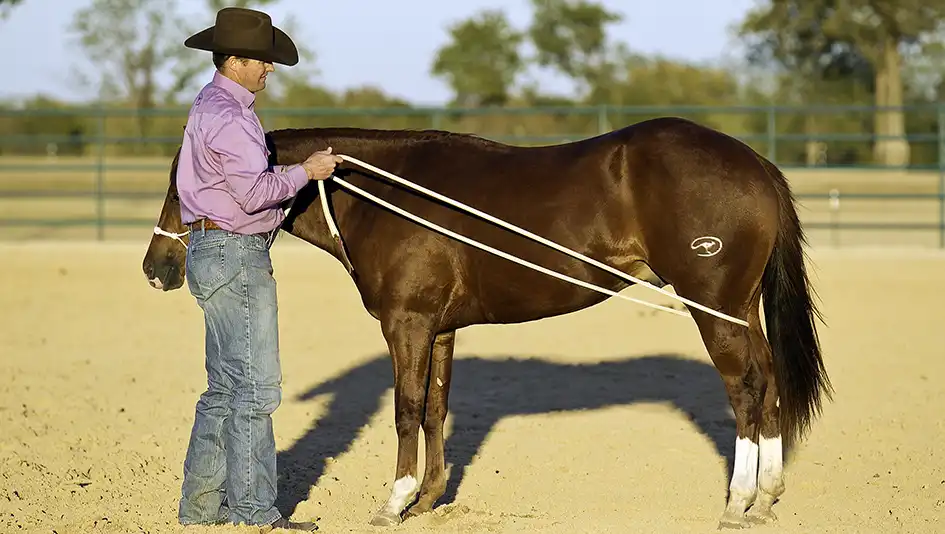
Seesawing the rope on Blue’s leg allowed me to build his confidence about having his leg touched while keeping myself in a safe position in case he kicked.
Consistency Is Key
The most important thing I wanted to get across to Cindy was that if she wanted Blue to truly get over his fear of having his legs handled, she needed to work with him every day. Just like children, horses learn best with consistency. Even though in the one day that I worked with Blue he progressed well, I warned Cindy that if she took him home and didn’t work on earning his respect and didn’t handle his legs in the manner I taught her, Blue would go right back to being the reactive, fearful horse he was before. With horses, it’s important to remember that consistency is your greatest ally, and inconsistency is your greatest enemy.
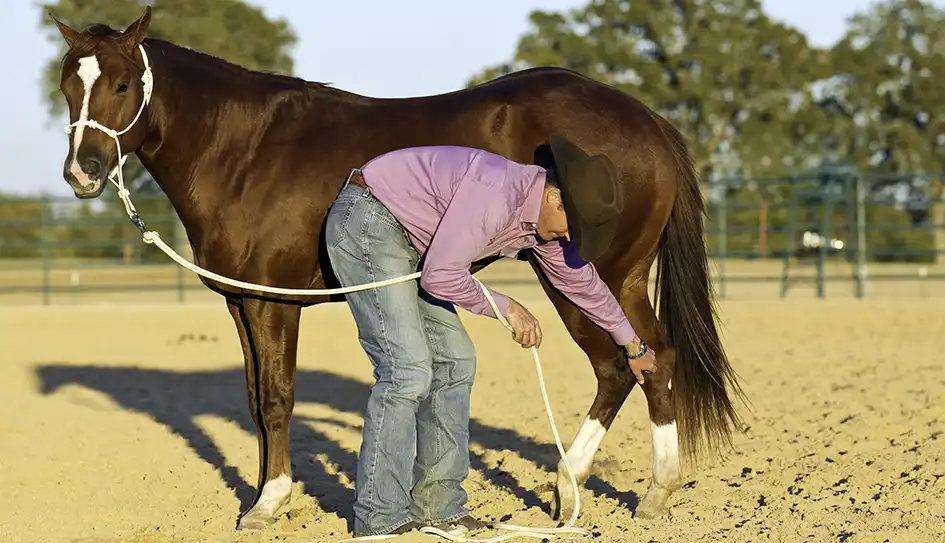
My cue for a horse to pick up his back leg is to lightly squeeze the cap of his hock.
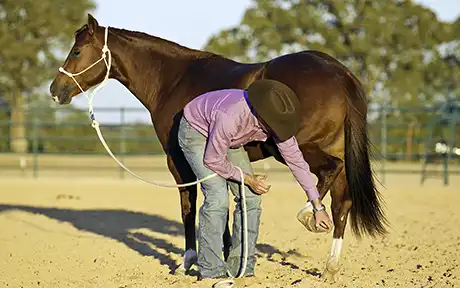

The key to building Blue’s confidence about having his foot handled was to initially hold it for a split second. Each time I picked his leg up, I tried to build on the amount of time I could hold it until I was able to hold it between my legs.
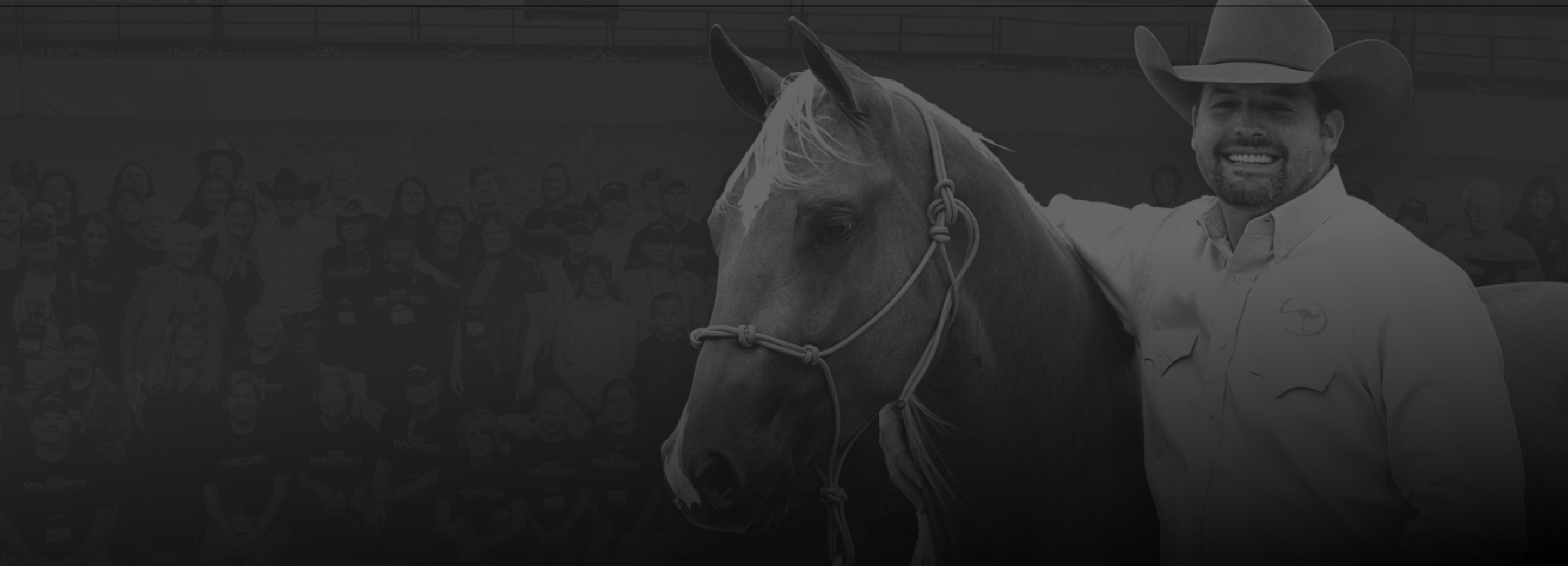
Master Your horsemanship Skills
Like these tips? Join the No Worries Club and hone your skills with thousands of hours of Clinton’s easy, step-by-step method horse training videos.


